Professional Diversity Practice in Healthcare: Competence & Safety
VerifiedAdded on 2023/06/03
|6
|1514
|181
Essay
AI Summary
This essay explores the multifaceted concept of professional diversity, specifically within the healthcare sector, emphasizing the importance of cultural safety and cultural competence. It defines these terms, highlighting the significance of creating environments free from bias and prejudice, ensuring respect, and fostering effective communication. The essay delves into the historical context of cultural safety in Aotearoa New Zealand, influenced by the Treaty of Waitangi and its impact on Maori health. It differentiates between cultural competence and cultural safety, emphasizing how the former contributes to the latter. Furthermore, the essay discusses the Health Professionals Competence Assurance Act of 2003, which aims to protect citizens by ensuring health professionals' competence and cultural awareness. It underscores the importance of these concepts for counselors, particularly in the field of drug and alcohol abuse, advocating for continuous skill development to provide excellent service delivery to all individuals regardless of their background. The essay concludes by highlighting the need for strategies to address addiction and improve public health, emphasizing the role of healthcare professionals in these efforts.
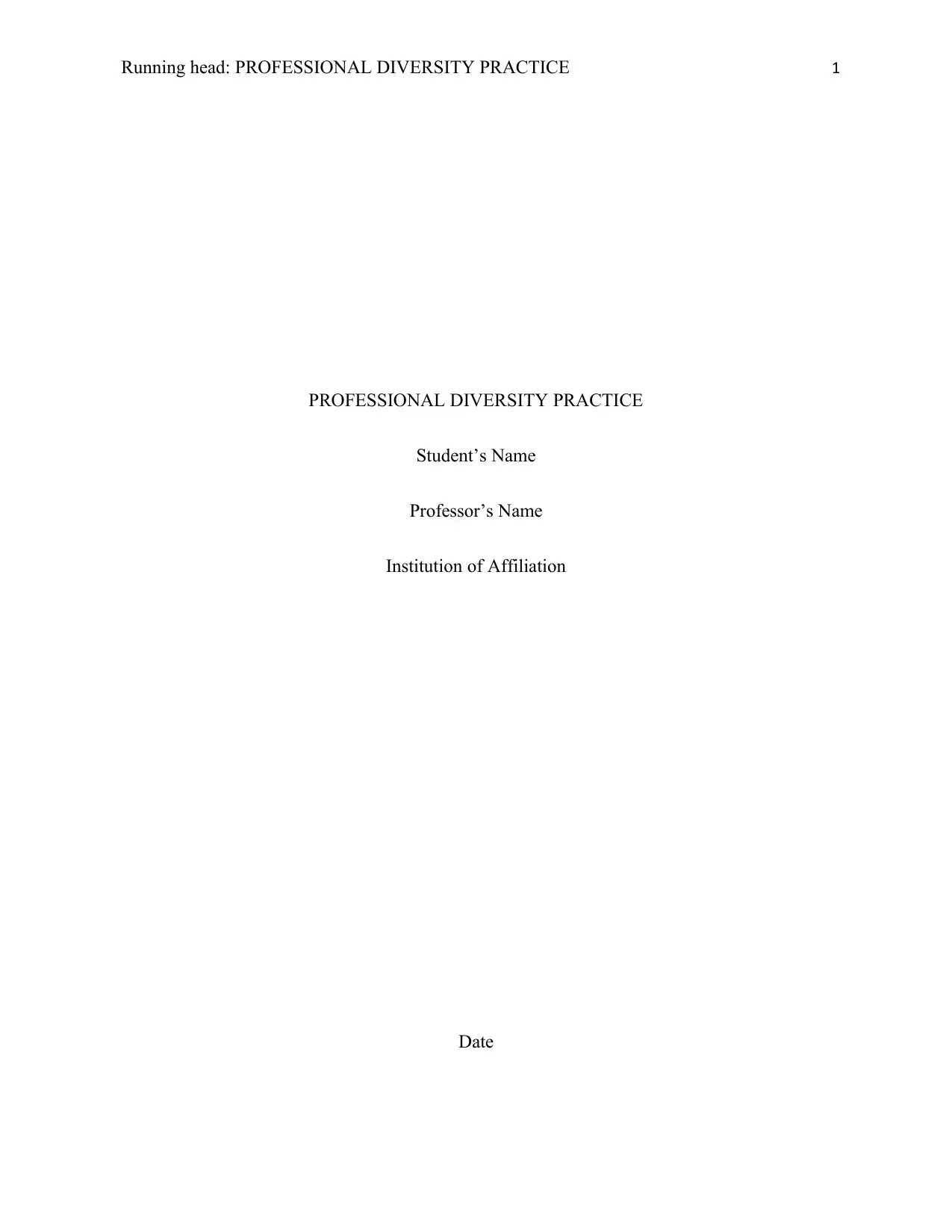
Running head: PROFESSIONAL DIVERSITY PRACTICE 1
PROFESSIONAL DIVERSITY PRACTICE
Student’s Name
Professor’s Name
Institution of Affiliation
Date
PROFESSIONAL DIVERSITY PRACTICE
Student’s Name
Professor’s Name
Institution of Affiliation
Date
Paraphrase This Document
Need a fresh take? Get an instant paraphrase of this document with our AI Paraphraser
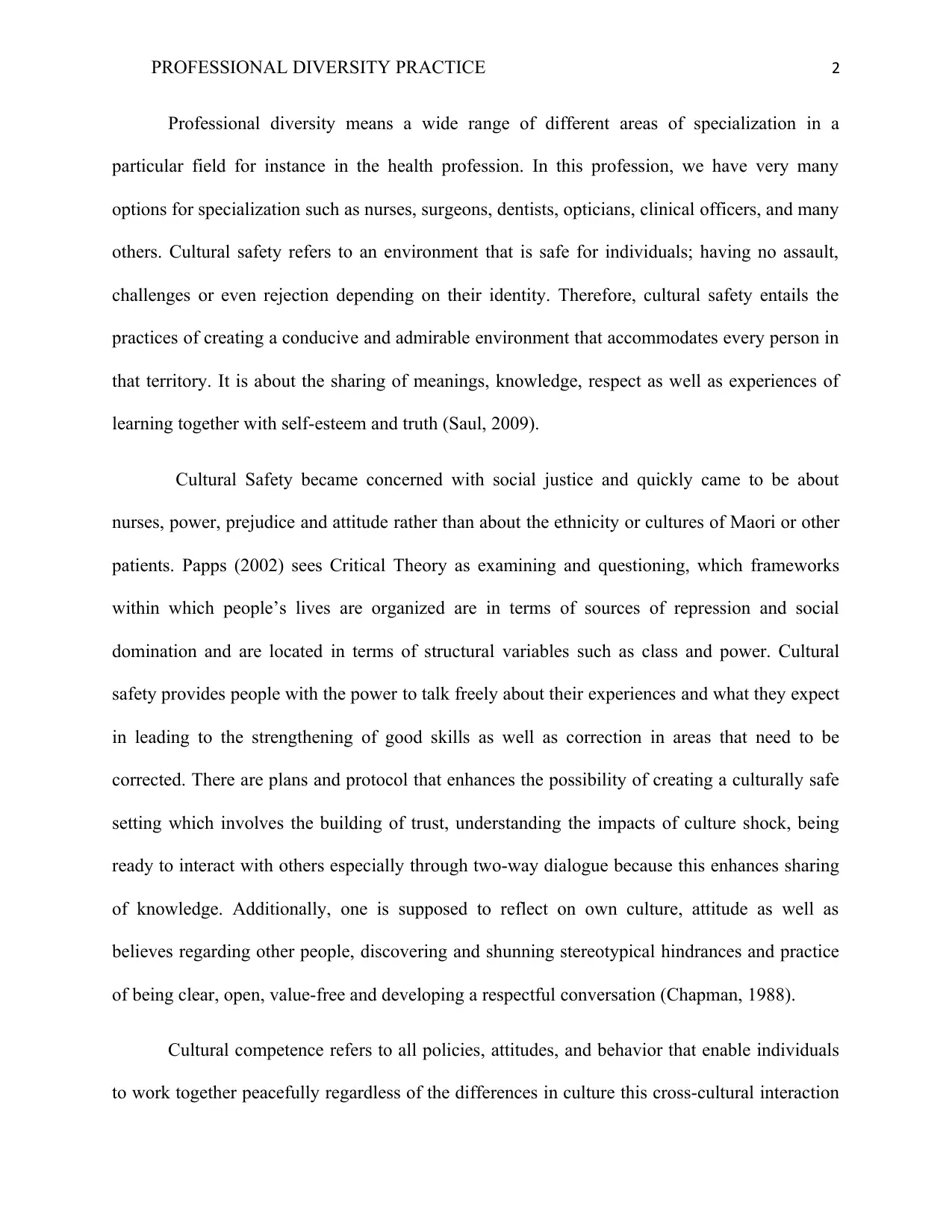
PROFESSIONAL DIVERSITY PRACTICE 2
Professional diversity means a wide range of different areas of specialization in a
particular field for instance in the health profession. In this profession, we have very many
options for specialization such as nurses, surgeons, dentists, opticians, clinical officers, and many
others. Cultural safety refers to an environment that is safe for individuals; having no assault,
challenges or even rejection depending on their identity. Therefore, cultural safety entails the
practices of creating a conducive and admirable environment that accommodates every person in
that territory. It is about the sharing of meanings, knowledge, respect as well as experiences of
learning together with self-esteem and truth (Saul, 2009).
Cultural Safety became concerned with social justice and quickly came to be about
nurses, power, prejudice and attitude rather than about the ethnicity or cultures of Maori or other
patients. Papps (2002) sees Critical Theory as examining and questioning, which frameworks
within which people’s lives are organized are in terms of sources of repression and social
domination and are located in terms of structural variables such as class and power. Cultural
safety provides people with the power to talk freely about their experiences and what they expect
in leading to the strengthening of good skills as well as correction in areas that need to be
corrected. There are plans and protocol that enhances the possibility of creating a culturally safe
setting which involves the building of trust, understanding the impacts of culture shock, being
ready to interact with others especially through two-way dialogue because this enhances sharing
of knowledge. Additionally, one is supposed to reflect on own culture, attitude as well as
believes regarding other people, discovering and shunning stereotypical hindrances and practice
of being clear, open, value-free and developing a respectful conversation (Chapman, 1988).
Cultural competence refers to all policies, attitudes, and behavior that enable individuals
to work together peacefully regardless of the differences in culture this cross-cultural interaction
Professional diversity means a wide range of different areas of specialization in a
particular field for instance in the health profession. In this profession, we have very many
options for specialization such as nurses, surgeons, dentists, opticians, clinical officers, and many
others. Cultural safety refers to an environment that is safe for individuals; having no assault,
challenges or even rejection depending on their identity. Therefore, cultural safety entails the
practices of creating a conducive and admirable environment that accommodates every person in
that territory. It is about the sharing of meanings, knowledge, respect as well as experiences of
learning together with self-esteem and truth (Saul, 2009).
Cultural Safety became concerned with social justice and quickly came to be about
nurses, power, prejudice and attitude rather than about the ethnicity or cultures of Maori or other
patients. Papps (2002) sees Critical Theory as examining and questioning, which frameworks
within which people’s lives are organized are in terms of sources of repression and social
domination and are located in terms of structural variables such as class and power. Cultural
safety provides people with the power to talk freely about their experiences and what they expect
in leading to the strengthening of good skills as well as correction in areas that need to be
corrected. There are plans and protocol that enhances the possibility of creating a culturally safe
setting which involves the building of trust, understanding the impacts of culture shock, being
ready to interact with others especially through two-way dialogue because this enhances sharing
of knowledge. Additionally, one is supposed to reflect on own culture, attitude as well as
believes regarding other people, discovering and shunning stereotypical hindrances and practice
of being clear, open, value-free and developing a respectful conversation (Chapman, 1988).
Cultural competence refers to all policies, attitudes, and behavior that enable individuals
to work together peacefully regardless of the differences in culture this cross-cultural interaction
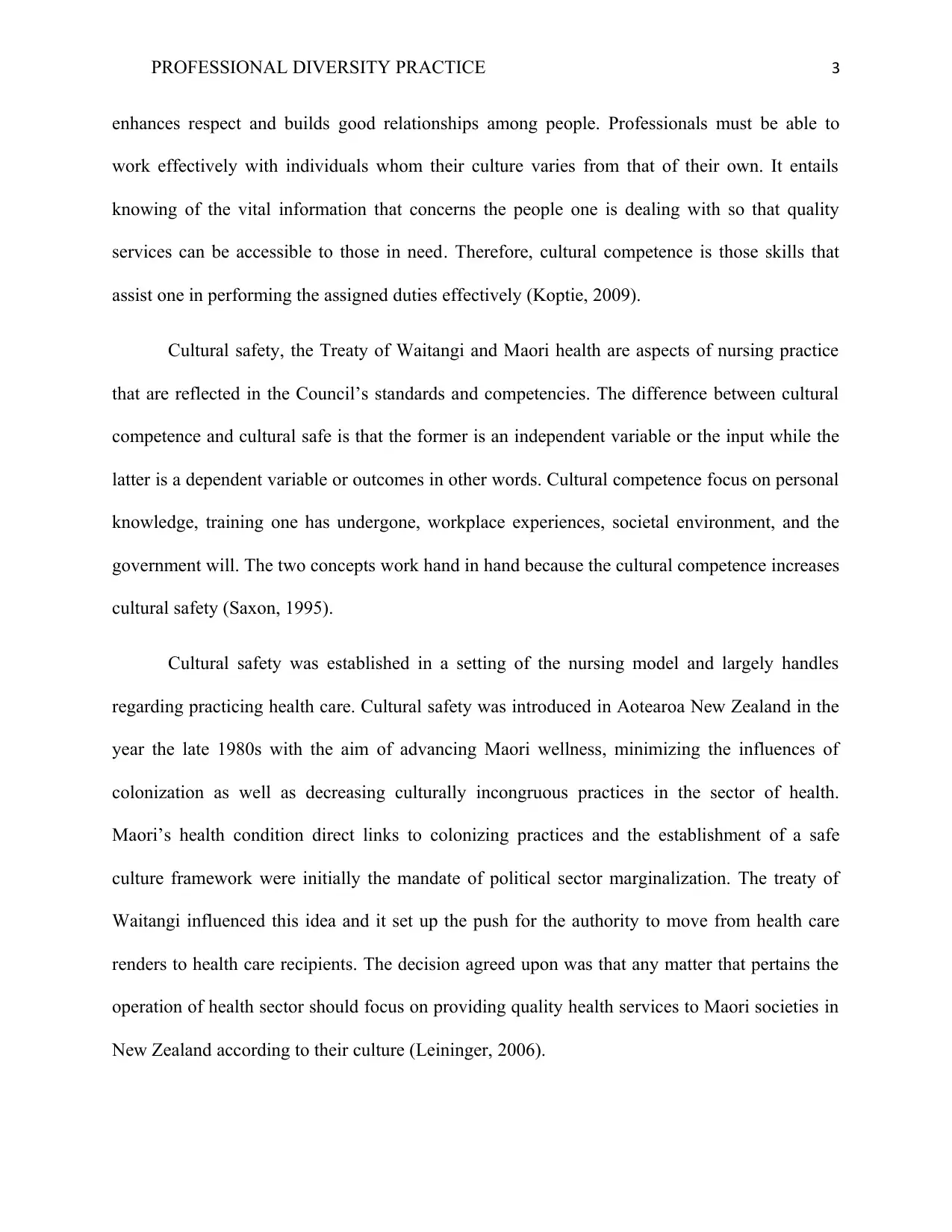
PROFESSIONAL DIVERSITY PRACTICE 3
enhances respect and builds good relationships among people. Professionals must be able to
work effectively with individuals whom their culture varies from that of their own. It entails
knowing of the vital information that concerns the people one is dealing with so that quality
services can be accessible to those in need. Therefore, cultural competence is those skills that
assist one in performing the assigned duties effectively (Koptie, 2009).
Cultural safety, the Treaty of Waitangi and Maori health are aspects of nursing practice
that are reflected in the Council’s standards and competencies. The difference between cultural
competence and cultural safe is that the former is an independent variable or the input while the
latter is a dependent variable or outcomes in other words. Cultural competence focus on personal
knowledge, training one has undergone, workplace experiences, societal environment, and the
government will. The two concepts work hand in hand because the cultural competence increases
cultural safety (Saxon, 1995).
Cultural safety was established in a setting of the nursing model and largely handles
regarding practicing health care. Cultural safety was introduced in Aotearoa New Zealand in the
year the late 1980s with the aim of advancing Maori wellness, minimizing the influences of
colonization as well as decreasing culturally incongruous practices in the sector of health.
Maori’s health condition direct links to colonizing practices and the establishment of a safe
culture framework were initially the mandate of political sector marginalization. The treaty of
Waitangi influenced this idea and it set up the push for the authority to move from health care
renders to health care recipients. The decision agreed upon was that any matter that pertains the
operation of health sector should focus on providing quality health services to Maori societies in
New Zealand according to their culture (Leininger, 2006).
enhances respect and builds good relationships among people. Professionals must be able to
work effectively with individuals whom their culture varies from that of their own. It entails
knowing of the vital information that concerns the people one is dealing with so that quality
services can be accessible to those in need. Therefore, cultural competence is those skills that
assist one in performing the assigned duties effectively (Koptie, 2009).
Cultural safety, the Treaty of Waitangi and Maori health are aspects of nursing practice
that are reflected in the Council’s standards and competencies. The difference between cultural
competence and cultural safe is that the former is an independent variable or the input while the
latter is a dependent variable or outcomes in other words. Cultural competence focus on personal
knowledge, training one has undergone, workplace experiences, societal environment, and the
government will. The two concepts work hand in hand because the cultural competence increases
cultural safety (Saxon, 1995).
Cultural safety was established in a setting of the nursing model and largely handles
regarding practicing health care. Cultural safety was introduced in Aotearoa New Zealand in the
year the late 1980s with the aim of advancing Maori wellness, minimizing the influences of
colonization as well as decreasing culturally incongruous practices in the sector of health.
Maori’s health condition direct links to colonizing practices and the establishment of a safe
culture framework were initially the mandate of political sector marginalization. The treaty of
Waitangi influenced this idea and it set up the push for the authority to move from health care
renders to health care recipients. The decision agreed upon was that any matter that pertains the
operation of health sector should focus on providing quality health services to Maori societies in
New Zealand according to their culture (Leininger, 2006).
⊘ This is a preview!⊘
Do you want full access?
Subscribe today to unlock all pages.

Trusted by 1+ million students worldwide
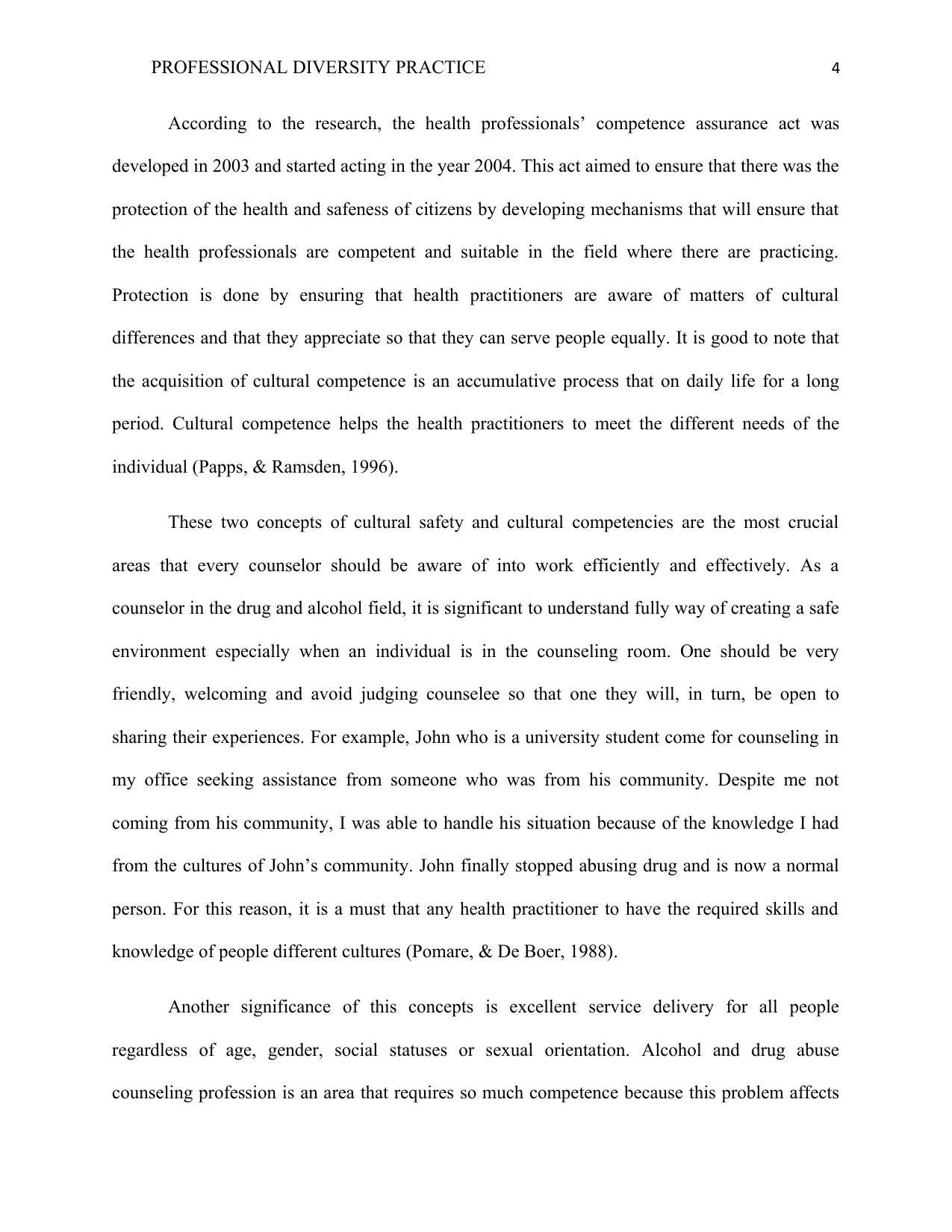
PROFESSIONAL DIVERSITY PRACTICE 4
According to the research, the health professionals’ competence assurance act was
developed in 2003 and started acting in the year 2004. This act aimed to ensure that there was the
protection of the health and safeness of citizens by developing mechanisms that will ensure that
the health professionals are competent and suitable in the field where there are practicing.
Protection is done by ensuring that health practitioners are aware of matters of cultural
differences and that they appreciate so that they can serve people equally. It is good to note that
the acquisition of cultural competence is an accumulative process that on daily life for a long
period. Cultural competence helps the health practitioners to meet the different needs of the
individual (Papps, & Ramsden, 1996).
These two concepts of cultural safety and cultural competencies are the most crucial
areas that every counselor should be aware of into work efficiently and effectively. As a
counselor in the drug and alcohol field, it is significant to understand fully way of creating a safe
environment especially when an individual is in the counseling room. One should be very
friendly, welcoming and avoid judging counselee so that one they will, in turn, be open to
sharing their experiences. For example, John who is a university student come for counseling in
my office seeking assistance from someone who was from his community. Despite me not
coming from his community, I was able to handle his situation because of the knowledge I had
from the cultures of John’s community. John finally stopped abusing drug and is now a normal
person. For this reason, it is a must that any health practitioner to have the required skills and
knowledge of people different cultures (Pomare, & De Boer, 1988).
Another significance of this concepts is excellent service delivery for all people
regardless of age, gender, social statuses or sexual orientation. Alcohol and drug abuse
counseling profession is an area that requires so much competence because this problem affects
According to the research, the health professionals’ competence assurance act was
developed in 2003 and started acting in the year 2004. This act aimed to ensure that there was the
protection of the health and safeness of citizens by developing mechanisms that will ensure that
the health professionals are competent and suitable in the field where there are practicing.
Protection is done by ensuring that health practitioners are aware of matters of cultural
differences and that they appreciate so that they can serve people equally. It is good to note that
the acquisition of cultural competence is an accumulative process that on daily life for a long
period. Cultural competence helps the health practitioners to meet the different needs of the
individual (Papps, & Ramsden, 1996).
These two concepts of cultural safety and cultural competencies are the most crucial
areas that every counselor should be aware of into work efficiently and effectively. As a
counselor in the drug and alcohol field, it is significant to understand fully way of creating a safe
environment especially when an individual is in the counseling room. One should be very
friendly, welcoming and avoid judging counselee so that one they will, in turn, be open to
sharing their experiences. For example, John who is a university student come for counseling in
my office seeking assistance from someone who was from his community. Despite me not
coming from his community, I was able to handle his situation because of the knowledge I had
from the cultures of John’s community. John finally stopped abusing drug and is now a normal
person. For this reason, it is a must that any health practitioner to have the required skills and
knowledge of people different cultures (Pomare, & De Boer, 1988).
Another significance of this concepts is excellent service delivery for all people
regardless of age, gender, social statuses or sexual orientation. Alcohol and drug abuse
counseling profession is an area that requires so much competence because this problem affects
Paraphrase This Document
Need a fresh take? Get an instant paraphrase of this document with our AI Paraphraser
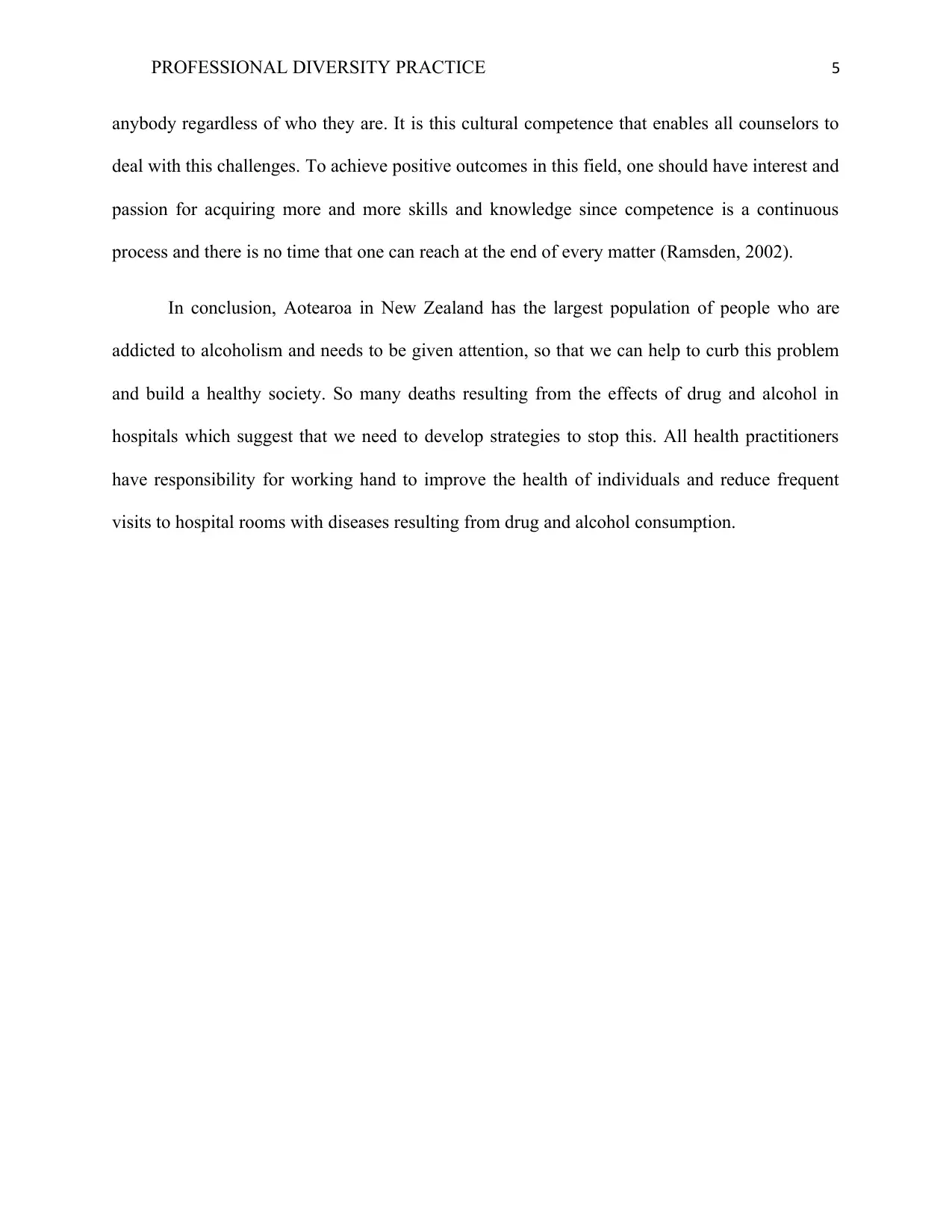
PROFESSIONAL DIVERSITY PRACTICE 5
anybody regardless of who they are. It is this cultural competence that enables all counselors to
deal with this challenges. To achieve positive outcomes in this field, one should have interest and
passion for acquiring more and more skills and knowledge since competence is a continuous
process and there is no time that one can reach at the end of every matter (Ramsden, 2002).
In conclusion, Aotearoa in New Zealand has the largest population of people who are
addicted to alcoholism and needs to be given attention, so that we can help to curb this problem
and build a healthy society. So many deaths resulting from the effects of drug and alcohol in
hospitals which suggest that we need to develop strategies to stop this. All health practitioners
have responsibility for working hand to improve the health of individuals and reduce frequent
visits to hospital rooms with diseases resulting from drug and alcohol consumption.
anybody regardless of who they are. It is this cultural competence that enables all counselors to
deal with this challenges. To achieve positive outcomes in this field, one should have interest and
passion for acquiring more and more skills and knowledge since competence is a continuous
process and there is no time that one can reach at the end of every matter (Ramsden, 2002).
In conclusion, Aotearoa in New Zealand has the largest population of people who are
addicted to alcoholism and needs to be given attention, so that we can help to curb this problem
and build a healthy society. So many deaths resulting from the effects of drug and alcohol in
hospitals which suggest that we need to develop strategies to stop this. All health practitioners
have responsibility for working hand to improve the health of individuals and reduce frequent
visits to hospital rooms with diseases resulting from drug and alcohol consumption.
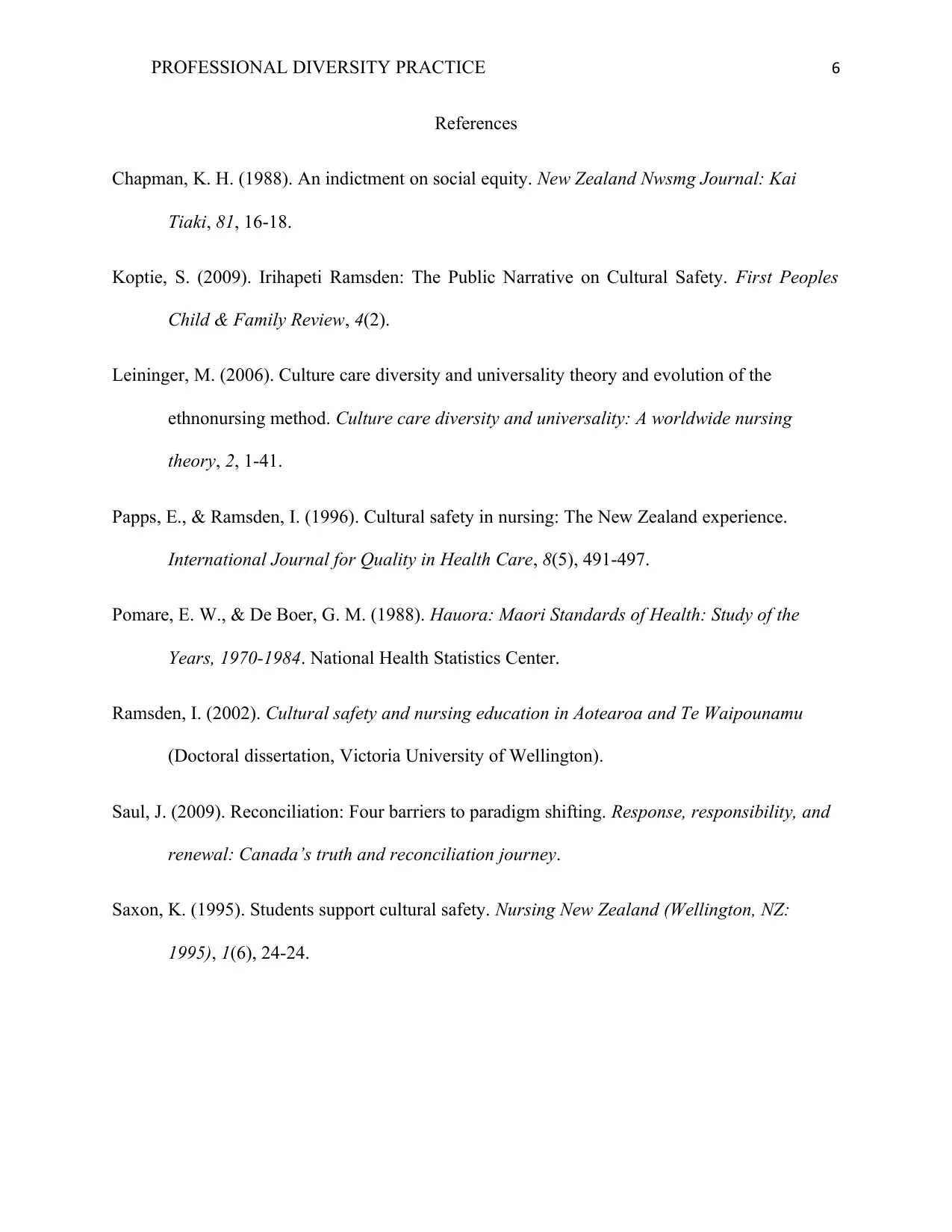
PROFESSIONAL DIVERSITY PRACTICE 6
References
Chapman, K. H. (1988). An indictment on social equity. New Zealand Nwsmg Journal: Kai
Tiaki, 81, 16-18.
Koptie, S. (2009). Irihapeti Ramsden: The Public Narrative on Cultural Safety. First Peoples
Child & Family Review, 4(2).
Leininger, M. (2006). Culture care diversity and universality theory and evolution of the
ethnonursing method. Culture care diversity and universality: A worldwide nursing
theory, 2, 1-41.
Papps, E., & Ramsden, I. (1996). Cultural safety in nursing: The New Zealand experience.
International Journal for Quality in Health Care, 8(5), 491-497.
Pomare, E. W., & De Boer, G. M. (1988). Hauora: Maori Standards of Health: Study of the
Years, 1970-1984. National Health Statistics Center.
Ramsden, I. (2002). Cultural safety and nursing education in Aotearoa and Te Waipounamu
(Doctoral dissertation, Victoria University of Wellington).
Saul, J. (2009). Reconciliation: Four barriers to paradigm shifting. Response, responsibility, and
renewal: Canada’s truth and reconciliation journey.
Saxon, K. (1995). Students support cultural safety. Nursing New Zealand (Wellington, NZ:
1995), 1(6), 24-24.
References
Chapman, K. H. (1988). An indictment on social equity. New Zealand Nwsmg Journal: Kai
Tiaki, 81, 16-18.
Koptie, S. (2009). Irihapeti Ramsden: The Public Narrative on Cultural Safety. First Peoples
Child & Family Review, 4(2).
Leininger, M. (2006). Culture care diversity and universality theory and evolution of the
ethnonursing method. Culture care diversity and universality: A worldwide nursing
theory, 2, 1-41.
Papps, E., & Ramsden, I. (1996). Cultural safety in nursing: The New Zealand experience.
International Journal for Quality in Health Care, 8(5), 491-497.
Pomare, E. W., & De Boer, G. M. (1988). Hauora: Maori Standards of Health: Study of the
Years, 1970-1984. National Health Statistics Center.
Ramsden, I. (2002). Cultural safety and nursing education in Aotearoa and Te Waipounamu
(Doctoral dissertation, Victoria University of Wellington).
Saul, J. (2009). Reconciliation: Four barriers to paradigm shifting. Response, responsibility, and
renewal: Canada’s truth and reconciliation journey.
Saxon, K. (1995). Students support cultural safety. Nursing New Zealand (Wellington, NZ:
1995), 1(6), 24-24.
⊘ This is a preview!⊘
Do you want full access?
Subscribe today to unlock all pages.

Trusted by 1+ million students worldwide
1 out of 6
Related Documents
Your All-in-One AI-Powered Toolkit for Academic Success.
+13062052269
info@desklib.com
Available 24*7 on WhatsApp / Email
![[object Object]](/_next/static/media/star-bottom.7253800d.svg)
Unlock your academic potential
Copyright © 2020–2025 A2Z Services. All Rights Reserved. Developed and managed by ZUCOL.





